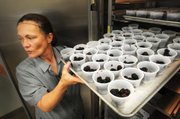For some children, the last day of school signals the start of summer fun -- long days spent playing outside, riding bikes, swimming and taking family vacations. But for nearly a quarter million Arkansas children, summer can mean a growling tummy.
When school shuts down, so do free and reduced-price breakfasts and lunches.
As a result, low-income families across the country will spend, on average, as much as $300 more a month in the summer making up the difference, according to the U.S. Department of Agriculture.
Many Arkansas families know this reality, says Nancy Conley, communications director for the Arkansas Hunger Relief Alliance in Little Rock.
"For the 2012-2013 school year, 246,000 students in Arkansas participated in the free or reduced-price lunch programs," Conley says.
To help families cope, the USDA Summer Food Service Program steps in to offer free summer meals to those 18 and younger at safe, supervised locations such as schools, community centers, parks, Boys & Girls Clubs, libraries and other sponsor sites.
"Safety was the biggest concern," Conley says. "Most of these parents are working, and they wanted to make sure it was a safe and secure environment and that it also offered
some type of enrichment programs."
Funding to feed children, provided by USDA, is funneled locally through the state Human Services Department. From there, the number of meals served at each location is tallied weekly, with participating sites reimbursed the next week.
All of the locations will be open sites, meaning that even children who are not enrolled in a site's programs may eat breakfast and lunch there.
Last summer, there were 882 USDA-reimbursed feeding sites for children in the state, according to statistics from the Human Services Department.
To find a site, Arkansans can call the National Hunger Hotline at (866) 348-6479 (866-3HUNGRY), text FOODAR to 877-877 or visit whyhunger.org/findfood.
The National Hunger Clearinghouse manages the hotline to connect people in need with food pantries, soup kitchens, government programs and other organizations.
Meanwhile, Why Hunger, which supports community-based organizations as they develop, has created a national directory to connect those searching for food with providers in their area. "As more sponsors are approved to come on board with the program, the Arkansas Department of Human Services will upload that information to the whyhunger.org website," Conley says.
WEEKDAY MEALS
The Arkansas Foodbank, the largest food bank in the state, also participates in the USDA summer meals program. Foodbank sponsors two feeding sites open Mondays through Fridays -- Paul Bewie Boys & Girls Club in Hot Springs Village and Saline County Boys & Girls Club in Benton.
The locations, in addition to others involved across the state, will serve two meals -- breakfast and lunch -- each weekday June through August. More than 400 children will be fed at the Saline County site while another 100 are expected at Hot Springs Village.
"Mention Hot Springs Village and people think, 'That's a retirement community and the people there have money. Why do they need this kind of program?'" says Sikia Brown, child program services coordinator for Arkansas Foodbank. "But this is the Jessieville School District, and it's a community in need. Eighty percent of the students there receive free or reduced-price lunches."
Meanwhile, at the Boys & Girls Club on the outer edge of Saline County, a rural area, more than 65 percent of the club's children, on average, depend on free or reduced-price lunches at school, Brown says, citing figures from the Arkansas Department of Education for 2013-2014.
Arkansas Foodbank works with faith-based and community-based nonprofits to feed hungry people.
Brown says the food pantries that Foodbank supports see an increased need in summer among working families with children. "In addition to their losing the free or reduced-priced meals at schools, they are also dealing with the additional cost of child care because the children aren't in school.
"And also in the summer, their utility bills increase, so they are taking hits from all directions," she says.
"Many of them may have money at the beginning of the month, but after they've paid those bills, by the middle or the end of the month, a lot of the pantries will see a rise in those needing help."
Such families can get boxes of food at Foodbank supported pantries.
BACKPACKS FOR THE WEEKEND
"Last summer, we began working in Marianna with the Delta Dreams [food pantry] and sponsored a summer backpack program," Brown says. Every Friday, children in the program took home a backpack filled with three to four meals to help get them through the weekend.
Marianna is in Lee County, where 100 percent of students receive free or reduced-price lunches.
Across the state, Arkansas Foodbank assists 23 after-school snack programs and five after-school supper sites, three in Little Rock and two in North Little Rock.
"Through the snack program, students get an early snack between 3 and 4 p.m.," Brown says, "and at the supper sites, they are served dinner."
And then there are the school-based pantries, located either in schools or at a site nearby, where students in need receive either food in their backpacks or boxes for their families.
Currently, the Foodbank works with nine school-based pantries, five in central Arkansas, and one each in southeastern Arkansas, Garland County, Hector (Pope County) and Clinton (Van Buren County).
"We've found that once a child gets past elementary school age, they become embarrassed to accept the assistance," Brown says. "So in those cases, if it's known that an elementary school student has older siblings, a worker at the pantry will contact the parent and arrange for a box with enough food to feed the entire family to be delivered to them."
LEARNING ON THE MENU
Working out of Temple Baptist Church on Interstate 30 in southwest Little Rock, the Life Skills for Youth program founded by Larry Clark offers a weekday children's program June 16 through Aug. 15.
"We focus on life skills, have health and fitness programs, and also help kids with their academics," Clark says. While there, the children also eat breakfast and lunch. Skills for Youth has been a part of the USDA summer feeding program for four years.
About 180 children enroll in the program with another 30 dropping in for meals -- mainly lunch, Clark says. The meals are prepared on-site by cafeteria workers hired using USDA funds.
"We post the menus," he says. "The kids are always excited to see what the meals are going to be. We make sure we feed them healthy foods."
He has visited some of the children's homes.
"At home, they don't have a lot of healthy foods -- apples, oranges or grapes. Their parents either just don't buy that type of food or they can't afford to," he says, adding that hunger comes in all colors. "These children in need are blacks, Latinos and whites."
Providing food complements his other programs, Clark says.
"When you're hungry, that's all you're thinking about," he explains. "But once a child has been fed, then they have more energy and can be more focused and concentrate on other things, like learning."
He can tell when the children return on Mondays that some of them haven't had enough to eat over the weekend. Malnourished children are irritable, tired, distracted.
"I just can't imagine having a summer program and not having a feeding program to go along with it," he says.
Family on 06/04/2014


